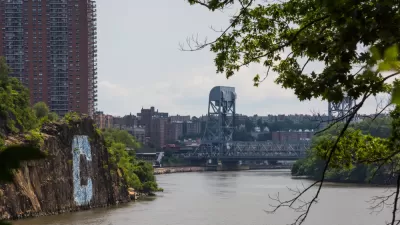The $5.46 billion sale last October for the private 83 acres of Stuyvesant Town and Peter Cooper Village barely topped the prior world record set for the same property in 2006 and preserved 5,000 apartments for middle income renters.
The biggest real estate sale in world history occurred nine years ago, when MetLife sold Stuyvesant Town–Peter Cooper Village, the largest apartment complex in Manhattan, to Tishman Speyer Properties and BlackRock real estate for $5.4 billion.
The properties were resold last October to the Blackstone Group and Ivanhoe Cambridge for $60,000 more, $5.46 billion, although there does seem to be some confusion on the actual price, as Konrad Putzier explains in The Real Deal.
Of far greater consequence is a special agreement in the sale that will allow almost half of the tenants of the 110 buildings and 11,232 apartments on the East Side of Manhattan "stretching from First Avenue to Avenue C, between 14th and 23rd Streets" (per Wikipedia) to sleep easier knowing that the new owners "committed that rents for 5,000 apartments [45%] would remain affordable to middle-class families for the next 20 years," wrote The New York Times' Charles V. Bagli on Oct. 19, 2015.
The agreement represents a victory for (Mayor Bill) de Blasio, who has made affordable housing a central tenet of his administration. Up to now, tenant activists and elected officials have feared that Stuyvesant Town’s 65-year history as a middle-class bastion was ending.
"The agreement also offers new protections for roughly 1,400 'Roberts' units," according to Blackstone's press release on Dec. 18.
Planetizen has no less than nine posts spanning from 2006, just before the first sale of the two private properties by MetLife to to Tishman Speyer Properties and BlackRock real estate, to 2010 when the sale "went kaput after the venture was unable to restructure the $4.4 billion in debt."
"The two properties, built with tax breaks and other subsidies for middle-income residents for returning WWII veterans, stretch over 10 blocks from 14th to 23rd streets," according to the Oct. 19, 2006 post describing the first sale. "They are viewed as among the last remaining middle-class developments on Manhattan."
A last-minute snafu erupted when "SL Green Realty Corporation, New York City’s largest commercial landlord, dropped a bombshell: It told real estate executives and city officials last week that it would file a lawsuit to block the imminent $5.45 billion sale," writes Charles V. Bagli for The New York Times on Dec. 18.
A lawsuit could upend a deal that they had hoped would close the books on one of the biggest financial debacles of the debt-fueled real estate boom in 2006.[...] On Friday afternoon (Dec. 18), the record-breaking sale to Blackstone was completed without any sign of a lawsuit.
Summarizing the record sale from all the stakeholders' perspectives, Douglas Harmon, the broker with Eastdil Secured who organized the Stuyvesant Town sale said, "No stakeholder — the buyers, the seller, bondholders, tenants or politicians — is displeased with the result," writes Bagli.
Of interest to readers may be the roles of two opposing giants in New York urban planning history, Robert Moses and Jane Jacobs. While Moses was a driving force for its creation, Jacobs opposed it due to its lack of street life, as explained in a Gotham Gazette article in 2006 (posted here).
FULL STORY: What’s the deal? Did Stuy Town break a world price record or not?

Alabama: Trump Terminates Settlements for Black Communities Harmed By Raw Sewage
Trump deemed the landmark civil rights agreement “illegal DEI and environmental justice policy.”

Study: Maui’s Plan to Convert Vacation Rentals to Long-Term Housing Could Cause Nearly $1 Billion Economic Loss
The plan would reduce visitor accommodation by 25% resulting in 1,900 jobs lost.

Planetizen Federal Action Tracker
A weekly monitor of how Trump’s orders and actions are impacting planners and planning in America.

Wind Energy on the Rise Despite Federal Policy Reversal
The Trump administration is revoking federal support for renewable energy, but demand for new projects continues unabated.

Passengers Flock to Caltrain After Electrification
The new electric trains are running faster and more reliably, leading to strong ridership growth on the Bay Area rail system.

Texas Churches Rally Behind ‘Yes in God’s Back Yard’ Legislation
Religious leaders want the state to reduce zoning regulations to streamline leasing church-owned land to housing developers.
Urban Design for Planners 1: Software Tools
This six-course series explores essential urban design concepts using open source software and equips planners with the tools they need to participate fully in the urban design process.
Planning for Universal Design
Learn the tools for implementing Universal Design in planning regulations.
Caltrans
Smith Gee Studio
Institute for Housing and Urban Development Studies (IHS)
City of Grandview
Harvard GSD Executive Education
Toledo-Lucas County Plan Commissions
Salt Lake City
NYU Wagner Graduate School of Public Service




























